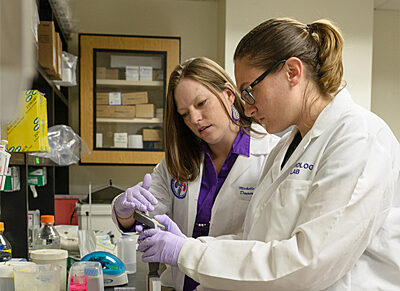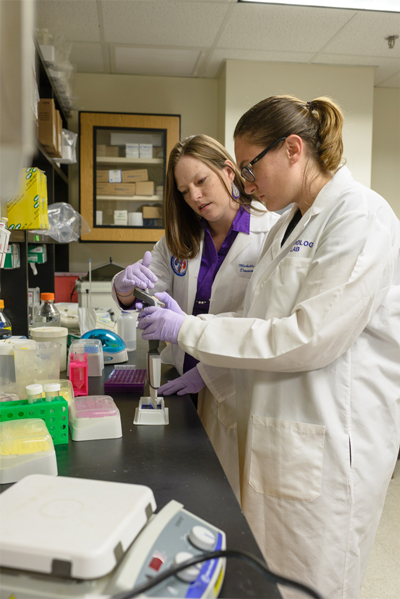The clock within — circadian rhythms and the cycle of life

As a new class of Nobel Prize laureates is honored Sunday at a ceremony in Stockholm, a University of Florida Health researcher nearly 5,000 miles away will reflect on just how far her research specialty has come.
Circadian rhythms are finally debutantes at the ball.
Three American scientists are receiving the 2017 Nobel Prize in physiology or medicine and sharing 9 million Swedish kroner, worth about $1.1 million. Jeffrey C. Hall and Michael Rosbash, both of Brandeis University, and Michael W. Young, of Rockefeller University, are being recognized for seminal work identifying the biological underpinnings of circadian rhythms.
“It’s a wonderful moment for everyone in the field,” said Michelle Gumz, Ph.D., an assistant professor of medicine in the UF College of Medicine who has studied circadian rhythms most of her career.
The moment is especially meaningful to Gumz, who works in the division of nephrology. In September she received a $1.47 million, five-year grant from the National Institutes of Health to study the role of circadian rhythms in the kidneys.
By studying that kidney clock, Gumz said, scientists may come to a better understanding of the underlying mechanisms causing high blood pressure. The research also may contribute to a better overall understanding of how circadian clock proteins regulate physiological function.

“What really excited me about this field is that there are so many areas that are just unexplored,” Gumz said. “And it’s applicable across all the kingdoms of life. It’s a truly ancient mechanism.”
Indeed, the Nobel laureates performed their research in the fruit fly, but their results are directly applicable to humans.
Circadian rhythms, the biological clock encoded in the DNA of all cells, had not been well understood until research on the topic blossomed in the 1970s and 1980s.
These molecular clocks keep life in tune with the rotation of the Earth and the cycle of night and day. In humans, our blood pressure and body temperature dip during the night.
Our highest testosterone secretion comes at 9 a.m., our highest alertness an hour later. By early afternoon, our best coordination and fastest reaction times are recorded. Around 5 p.m., our bodies are working at their greatest cardiovascular efficiency and muscle strength.
The Nobel laureates isolated a gene that triggers the biological rhythm, prize officials said when the awards were announced in October. The gene encodes a protein that accumulates in the cell during the night before degrading by day.
“With exquisite precision, our inner clock adapts our physiology to the dramatically different phases of the day,” the Nobel Assembly said in a news release. “The clock regulates critical functions such as behavior, hormone levels, sleep, body temperature and metabolism.
“Our well-being is affected when there is a temporary mismatch between our external environment and this internal biological clock.”
So, travel between time zones results in “jet lag,” or workers on the graveyard shift might have trouble sleeping during the day.
“The organisms that evolved this internal clock mechanism had a selective advantage if they were better adapted to the night/day environment,” Gumz said. “Then they would be able to better survive an injury, or escape a predator, or find food.”
Circadian rhythms have sometimes been ignored in biomedical research, as some scientists fail to fully recognize their importance in human biology, Gumz said.
As an example, she pointed out that many studies do not note the time of day when researchers collect data on mouse models. This could have ramifications for extending findings in rodents, which are nocturnal, to humans, who are mostly creatures of the day.
As with humans, the mouse model’s blood pressure varies, dipping at the nadir of their circadian day. For the mouse model, that dip comes during the day. For humans, it comes during the night.
The Nobel Prize for circadian rhythm research, Gumz said, lends considerable legitimacy to the field.
“That’s the main reason why we’re so excited by this,” she said. “There is this feeling that people will really begin to appreciate just how important this is, just how fundamental this is. That’s our hope.”
One of the things Gumz is studying in her grant research is the concept of non-dipping hypertension. Many humans have a misaligned circadian rhythm, and her lab has developed a mouse model to study this phenomenon.
Gumz said some among us may have blood pressure that does not dip at night. Extensive evidence from the medical literature shows that loss of the normal circadian rhythm for blood pressure is associated with increased risk for stroke, heart attack and overall adverse cardiovascular outcomes.
“So how do we intervene? How do we fix that?” she said. “The long-term goal of our research is to help improve patient care in terms of understanding the importance of time of day. Time of day for taking blood pressure measurements. Time of day for administering medication. And so, it’s always my hope that our mechanistic, basic science work will have an impact in terms of spreading the word to other researchers and physicians about the importance of circadian rhythms.”
To non-scientists, the concept of our organs and cells ticking to some internal timepiece may seem fanciful. In fact, it’s as real as a Rolex.
“Do your kidneys know what time it is?” Gumz asked in a 2015 paper.
The answer, of course, is ‘yes.’
About the author
